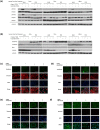A microRNA signature of response to erlotinib is descriptive of TGFβ behaviour in NSCLC
- PMID: 28646226
- PMCID: PMC5482799
- DOI: 10.1038/s41598-017-04097-7
A microRNA signature of response to erlotinib is descriptive of TGFβ behaviour in NSCLC
Abstract
Our previous work identified a 13-gene miRNA signature predictive of response to the epidermal growth factor receptor (EGFR) inhibitor, erlotinib, in Non-Small Cell Lung Cancer cell lines. Bioinformatic analysis of the signature showed a functional convergence on TGFβ canonical signalling. We hypothesized that TGFβ signalling controls expression of the miRNA genes comprising an erlotinib response signature in NSCLC. Western analysis revealed that TGFβ signalling via Smad2/3/4 occurred differently between erlotinib-resistant A549 and erlotinib- sensitive PC9 cells. We showed that TGFβ induced an interaction between Smad4 and putative Smad Binding Elements in PC9. However, qRT-PCR analysis showed that endogenous miR-140/141/200c expression changes resulted from time in treatments, not the treatments themselves. Moreover, flow cytometry indicated that cells exited the cell cycle in the same manner. Taken together these data indicated that the miRNA comprising the signature are likely regulated by the cell cycle rather than by TGFβ. Importantly, this work revealed that TGFβ did not induce EMT in PC9 cells, but rather TGFβ-inhibition induced an EMT-intermediate. These data also show that growth/proliferation signals by constitutively-activated EGFR may rely on TGFβ and a possible relationship between TGFβ and EGFR signalling may prevent EMT progression in this context rather than promote it.
Conflict of interest statement
The authors declare that they have no competing interests.
Figures






References
-
- The Cancer Genome Atlas Research, N. Comprehensive molecular profiling of lung adenocarcinoma. Nature 511, 543–550, doi:10.1038/nature13385http://www.nature.com/nature/journal/v511/n7511/abs/nature13385.html#sup... (2014). - PMC - PubMed
-
- Kim ES, et al. The BATTLE trial: personalizing therapy for lung cancer. Cancer discovery. 2011;1:44–53. doi: 10.1158/2159-8274.CD-10-0010. - DOI - PMC - PubMed
-
- Pao W, Miller VA. Epidermal growth factor receptor mutations, small-molecule kinase inhibitors, and non-small-cell lung cancer: current knowledge and future directions. Journal of clinical oncology: official journal of the American Society of Clinical Oncology. 2005;23:2556–2568. doi: 10.1200/JCO.2005.07.799. - DOI - PubMed
MeSH terms
Substances
Grants and funding
LinkOut - more resources
Full Text Sources
Other Literature Sources
Medical
Research Materials
Miscellaneous

